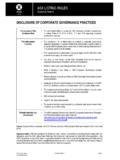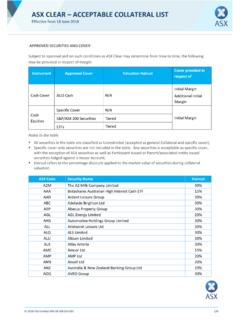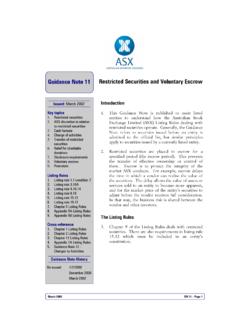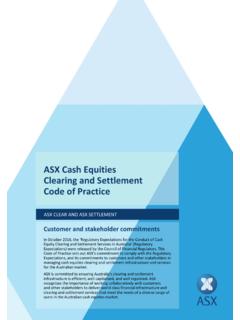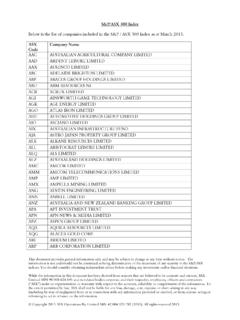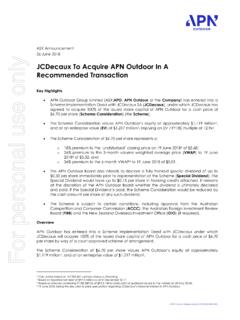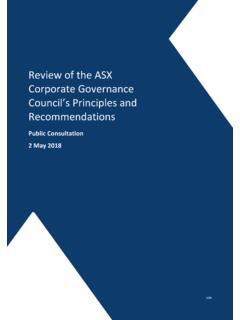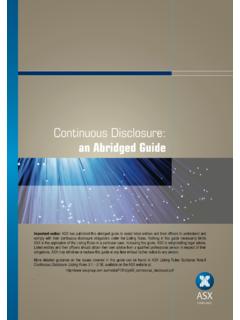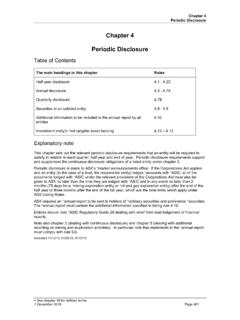Transcription of A Guide to Listing & the IPO Process in Australia - ASX
1 A Guide to Listing & the IPO Process in Australia1 Maddocks | A Guide to Listing & the IPO Process in AustraliaIntroduction 3 The decision to list 7 Eligibility to list 11 Indicative IPO timeline 16 Preparing for an IPO 19 The prospectus 25 The due diligence Process 31 Offer, structure, pricing & marketing restrictions 35 Engagement with ASX 39 Foreign companies Listing on ASX 43 Ongoing obligations 49 Authors 52 Our broader team 53 About Maddocks 54 Contents23A Guide to Listing & the IPO Process in Australia | MaddocksMaddocks | A Guide to Listing & the IPO Process in AustraliaIntroductionA Guide to Listing & the IPO Process in Australia aims to assist companies in determining whether they qualify for an Australian Securities Exchange (ASX) Listing .
2 It will also help with understanding what is involved in the initial public offering (IPO) Process by providing some practical guidance on how to prepare for an Guide is intended to be an overview of some of the key criteria for Listing and the Process involved to help companies to decide whether an ASX Listing may be a growth option for them, not as a comprehensive summary of all the steps and requirements involved in an ASX Listing . It is based on the ASX Listing rules and guidance that came into effect in September 2018. However, readers should be aware that ASX is proposing to introduce a number of changes to the Listing rules in 2019 which will have some impact on the IPO Process and ongoing obligations as a listed company. Headquarters of Australian Securities Exchange, Sydney NSW Australia45A Guide to Listing & the IPO Process in Australia | MaddocksMaddocks | A Guide to Listing & the IPO Process in AustraliaWhy ASX?
3 Many growing and successful private companies consider Listing on the ASX via an IPO at some stage in their development as a route to accelerate growth and to open up new opportunities for their business. In addition, numerous foreign companies list on ASX (either as a primary or dual Listing ) to access the Australian capital markets. Private equity and venture capital investors often work towards an IPO as an exit mechanism for their ASX has over 150 years of exchange experience and is one of the world s leading exchange groups. Operating in a robust regulatory environment, the ASX has over 150 years of exchange experience and is one of the world s leading exchange a highly active capital market, the ASX regularly attracts over 100 IPOs each year and provides companies with access to the largest pool of investable funds in Asia. Currently, the ASX has over 2,200 listed companies and issuers across diverse sectors, with a market capitalisation of more than $2 trillion.
4 In addition, the ASX has million share owners and 180 market How can Maddocks assist?Maddocks has an excellent track record assisting companies to make the decision to list and managing the legal aspects of the IPO Process . We also have close working relationships with: both ASX and the Australian Securities and Investments Commission (ASIC) to help the IPO regulatory Process corporate advisers, investment banks, stockbrokers and accountants to ensure the IPO team works seamlessly to deliver an efficient IPO aim to build long-term relationships with our clients through their IPO and into their listed life. Our partners are recognised for their hands-on and commercial approach to the myriad legal issues involved in an IPO. Our national team can assist on all aspects of the IPO Process , including: assessing whether the company is eligible to list on ASX structuring pre-IPO funding to flow into the IPO preparing for an ASX Listing by completing group reorganisations, implementing employee incentive plans and formalising appropriate corporate governance frameworks managing the due diligence Process for the IPO drafting certain sections of the prospectus and ensuring that the prospectus and other offer documents meet regulatory requirements seeking regulatory waivers and approvals from ASX and ASIC (in particular to facilitate foreign listings) negotiating underwriting agreements following Listing , supporting companies and boards to meet their disclosure, reporting and other obligations under the ASX Listing rules and Australian.
5 ASX | Capital with confidence A launch pad to accelerate your growthlisted companies and issuersyears of exchange experienceIPOs per yearmarket capitalisationshare ownersaverage daily turnover67A Guide to Listing & the IPO Process in Australia | MaddocksMaddocks | A Guide to Listing & the IPO Process in AustraliaThe decision to listListing on any stock exchange presents a range of opportunities and challenges for companies. The first step for a company considering an IPO and Listing is to weigh up these factors having regard to its own unique on building exterior at Federation Square, Melbourne, Victoria, Australia89A Guide to Listing & the IPO Process in Australia | MaddocksMaddocks | A Guide to Listing & the IPO Process in AustraliaOpportunitiesChallengesRaising capitalAn IPO raises capital for current operations, refinancing and expansion. A Listing also means that future equity capital raisings are simpler and cheaper.
6 Listed securities can also be used as a currency for acquisitions and to support debt of controlOnce a company completes an IPO, there is necessarily some loss of control for owners arising from dilution. In addition, ASX Listing rules require shareholder approval for many matters that were previously under the control of owners and management such as significant acquisitions or disposals, share issues and related party a market for the company s sharesA public Listing will create a market for trading in the company s shares, thereby creating liquidity in the shares. Liquidity is attractive to a wider section of the investment community and will ultimately broaden the shareholder change & privacyThere is a risk that the required changes to company structure, management and processes to enable it to operate as a listed company, may affect internal culture. There is also necessarily a loss of privacy for publicly listed companies, caused by media interest and compliance with regulatory disclosure the profile of the companyAn IPO provides a company with the opportunity to raise its profile in the media, as well as with customers, suppliers and investors, producing flow-on benefits to the of management focusThe IPO Process and the continuing operation of a company as a publicly listed company will require a significant investment of management time, and if not properly managed, could affect the company s business.
7 Providing an exit-strategy for early investorsAn IPO and Listing of a company can provide a desirable or necessary exit for early investors in the company. However, there may be restrictions which limit the number of shares that can be sold by founder shareholders, seed capitalists and other specified persons for a certain period after an IPO (see Engagement with ASX).Increased disclosure & corporate governanceA listed company must comply with comprehensive disclosure obligations, including financial performance and management remuneration. Complying with the ASX s corporate governance regime can also seem burdensome for companies used to operating in a private & retaining employeesEquity incentive schemes in listed companies are more attractive to current and prospective employees and can drive employee incentivisation, in turn benefiting the & future market conditionsShare prices and liquidity for listed companies are susceptible to general economic and market conditions which are outside the control of institutional investmentA public Listing is the platform to attract institutional investors which provide a company with market credibility and the support to grow its business.
8 Compulsory superannuation in Australia means that Australian institutions have access to one of the largest investment pools in the world. CostsThe IPO Process involves significant underwriting, professional adviser and ASX Listing fees in addition to other service fees and costs. Maintaining a Listing also involves ongoing costs such as audit costs, share registry fees, annual ASX Listing fees and annual general meeting efficiencies and transparencyThe continuous disclosure and corporate governance requirements for listed companies may promote better internal processes and reporting mechanisms, which may in turn lead to greater efficiency and Guide to Listing & the IPO Process in Australia | MaddocksMaddocks | A Guide to Listing & the IPO Process in AustraliaEligibility to listASX applies general tests and certain specific requirements for Listing a company. ASX also retains a general discretion not to list any company that it does not consider suitable to be listed on its exchange.
9 Whilst this is a wide discretion, it is exercised in only exceptional cases and usually where companies are not at a sufficiently advanced stage of development to Sydney Opera House, Sydney, NSW, Australia1213A Guide to Listing & the IPO Process in Australia | MaddocksMaddocks | A Guide to Listing & the IPO Process in AustraliaSpecific requirementsASX also imposes a number of specific conditions for Listing , including the following:Profits and assets tests A company must meet either the profits test or the assets test .Profits test requirementsAssets test requirements A$1 million aggregated profit over past 3 years; and A$500,000 consolidated profit over last 12 months and continuing profitability A$4 million net tangible assets after deducting costs of fundraising; or A$15 million market capitalisation3 years of audited accountsReviewed accounts for the half year if the last audited accounts are more than 6 months and 75 days old2 years of audited accountsReviewed accounts for the half year if the last audited accounts are more than 6 months and 75 days oldA$ million in working capital at Listing and ASX ordinarily also requires 12 months after Listing (which can include forecast revenue if included in the prospectus)2A statement in the prospectus that the company has enough working capital to carry out its stated objectivesIf a company lists under the assets test rather than the profits test, it will be subject to certain additional requirements following Listing .
10 Quarterly financial reportingThe company will be required to quarterly report its cashflows in addition to the standard half year and annual financial reporting if at the time of admission it has 50 percent or more of its tangible assets in cash (or a form readily convertible into cash).The company will be subject to quarterly reporting for at least 2 years following Listing or a longer period if it is not cash-flow (lock-up) of sharesFounder shareholders, seed capitalists and other specified early shareholders will usually be subject to the ASX imposed mandatory escrow (or lock-up) arrangements for their shares following Listing (see Engagement with ASX below).General testsASX must be satisfied that the company s structure and operations are appropriate for a listed entity. ASX considers (amongst others) the following matters carefully: capital structure Board experience legality of operations experience of auditors structure of business operations relationships with related parties/entities stage of development of business operations in emerging provides detailed guidance as to these matters and Maddocks has extensive experience in how ASX applies its guidance.
